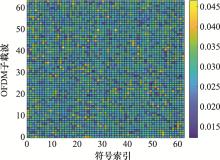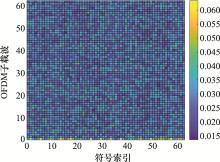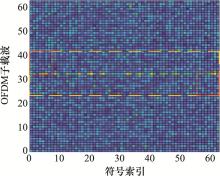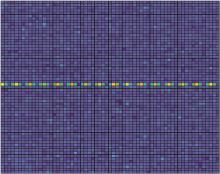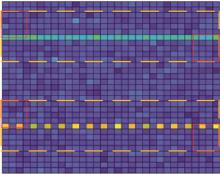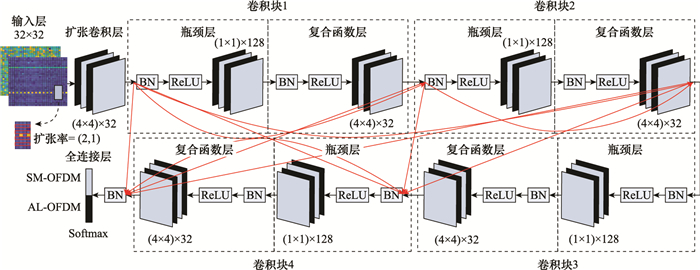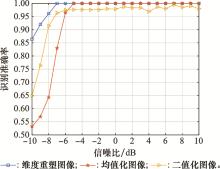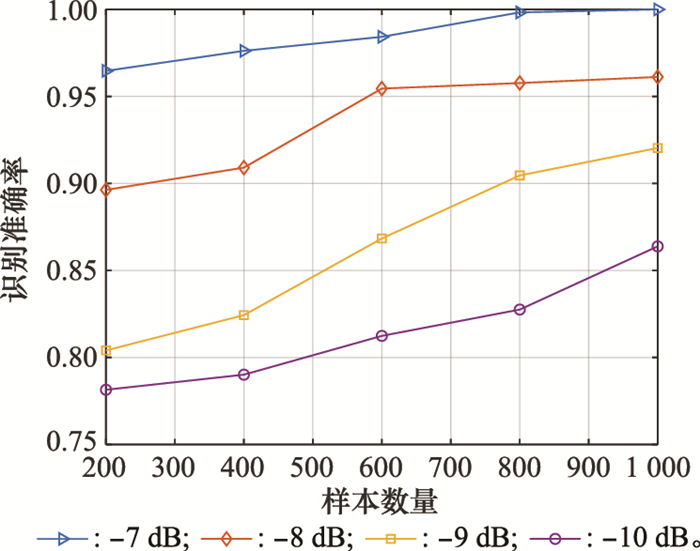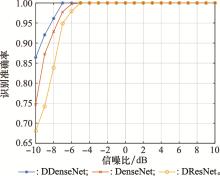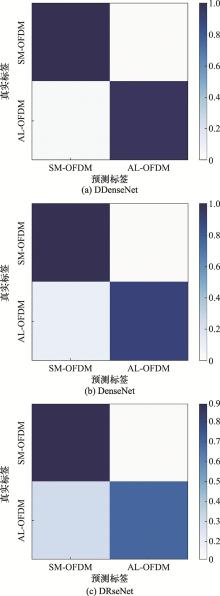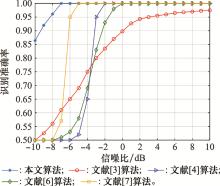Systems Engineering and Electronics ›› 2021, Vol. 43 ›› Issue (9): 2657-2664.doi: 10.12305/j.issn.1001-506X.2021.09.36
• Communications and Networks • Previous Articles Next Articles
SFBC-OFDM recognition method based on cross-correlation feature map and dilated dense convolutional neural networks
Yuyuan ZHANG, Limin ZHANG*, Wenjun YAN
- Academy of Aeronautical Operations Service, Naval Aeronautical University, Yantai 264001, China
-
Received:2020-10-20Online:2021-08-20Published:2021-08-26 -
Contact:Limin ZHANG
CLC Number:
Cite this article
Yuyuan ZHANG, Limin ZHANG, Wenjun YAN. SFBC-OFDM recognition method based on cross-correlation feature map and dilated dense convolutional neural networks[J]. Systems Engineering and Electronics, 2021, 43(9): 2657-2664.
share this article
| 1 | ELDEMERDASH Y A , DOBRE O A , ÖNER M . Signal identification for multiple-antenna wireless systems: achievements and challenges[J]. IEEE Communications Surveys & Tutorials, 2016, 18 (3): 1524- 1551. |
| 2 |
KARAMI E , DOBRE O A . Identification of SM-OFDM and AL-OFDM signals based on their second-order cyclostationarity[J]. IEEE Trans.on Vehicular Technology, 2015, 64 (3): 942- 953.
doi: 10.1109/TVT.2014.2326107 |
| 3 | GAO M J, LI Y Z, LI T, et al. Blind identification of MIMO-SFBC signals over frequency-selective channels[C]//Proc. of the IEEE Wireless Communications and Networking Conference, 2017. |
| 4 | GAO M J, LI Y Z, MAO L T, et al. Blind identification of SFBC-OFDM signals using two-dimensional space-frequency redundancy[C]//Proc. of the IEEE Global Communications Confe- rence, 2017. |
| 5 |
GAO M J , LI Y Z , DOBRE O A , et al. Blind identification of SFBC-OFDM signals based on the central limit theorem[J]. IEEE Trans.on Wireless Communications, 2019, 18 (7): 3500- 3514.
doi: 10.1109/TWC.2019.2914687 |
| 6 |
MAREY M , DOBRE O A . Automatic identification of space-frequency block coding for OFDM System[J]. IEEE Trans.on Wireless Communications, 2017, 16 (1): 117- 128.
doi: 10.1109/TWC.2016.2619676 |
| 7 |
GAO M J , LI Y Z , DOBRE O A , et al. Blind identification of SFBC-OFDM signals using subspace decompositions and random matrix theory[J]. IEEE Trans.on Vehicular Technology, 2018, 67 (10): 9619- 9630.
doi: 10.1109/TVT.2018.2859761 |
| 8 |
O'SHEA T J , ROY T , CLANCY T C . Over-the-air deep learning based radio signal classification[J]. IEEE Journal of Selected Topics in Signal Processing, 2018, 12 (1): 168- 179.
doi: 10.1109/JSTSP.2018.2797022 |
| 9 | MENG F , CHEN P , WU L N , et al. Automatic modulation classification a deep learning enabled approach[J]. IEEE Trans.on Vehicular Technology, 2018, 67 (11): 10760- 10772. |
| 10 |
WANG Y , LIU M , YANG J , et al. Data-driven deep learning for automatic modulation recognition in cognitive radios[J]. IEEE Trans.on Vehicular Technology, 2019, 68 (4): 4074- 4077.
doi: 10.1109/TVT.2019.2900460 |
| 11 |
KONG S H , KIM M J , HOANG L M , et al. Automatic LPI radar waveform recognition using CNN[J]. IEEE Access, 2018, 6, 4207- 4219.
doi: 10.1109/ACCESS.2017.2788942 |
| 12 |
黄颖坤, 金炜东, 余志斌, 等. 基于深度学习和集成学习的辐射源信号识别[J]. 系统工程与电子技术, 2018, 40 (11): 2420- 2425.
doi: 10.3969/j.issn.1001-506X.2018.11.05 |
|
HUANG Y K , JIN W D , YU Z B , et al. Radar emitter signal recognition based on deep learning and ensemble learning[J]. Systems Engineering and Electronics, 2018, 40 (11): 2420- 2425.
doi: 10.3969/j.issn.1001-506X.2018.11.05 |
|
| 13 | 郭立民, 寇韵涵, 陈涛, 等. 基于栈式稀疏自编码器的低信噪比下低截获概率雷达信号调制类型识别[J]. 电子与信息学报, 2018, 40 (4): 875- 881. |
| GUO L M , KOU Y H , CHEN T , et al. Low probability of intercept radar signal recognition based on stacked sparse auto-encoder[J]. Journal of Electronics & Information Technology, 2018, 40 (4): 875- 881. | |
| 14 |
秦鑫, 黄洁, 查雄, 等. 基于扩张残差网络的雷达辐射源信号识别[J]. 电子学报, 2020, 48 (3): 456- 462.
doi: 10.3969/j.issn.0372-2112.2020.03.006 |
|
QIN X , HUANG J , ZHA X , et al. Radar emitter signal recognition based on dilated residual network[J]. Acta Electronica Sinica, 2020, 48 (3): 456- 462.
doi: 10.3969/j.issn.0372-2112.2020.03.006 |
|
| 15 | YU F, KOLTUN V. Multi-scale context aggregation by dilated convolutions[EB/OL]. [2020-10-08]. https://arxiv.org/abs/1511.07122. |
| 16 | HUANG G, LIU Z, MAATEN L V D, et al. Densely connected convolutional networks[C]//Proc. of the IEEE Conference on Computer Vision and Pattern Recognition, 2017: 2261-2269. |
| 17 | POOJA K, NIDAMANURI R R, MISHRA D. Multi-scale dilated residual convolutional neural network for hyperspectral image classification[C]//Proc. of the 10th Workshop on Hyperspectral Imaging and Signal Processing: Evolution in Remote Sensing, 2019. |
| [1] | Xiao HAN, Shiwen CHEN, Meng CHEN, Jincheng YANG. Open-set recognition of LPI radar signal based on reciprocal point learning [J]. Systems Engineering and Electronics, 2022, 44(9): 2752-2759. |
| [2] | Limin ZHANG, Kaiwen TAN, Wenjun YAN, Yuyuan ZHANG. Radar emitter recognition based on multi-level jumper residual network [J]. Systems Engineering and Electronics, 2022, 44(7): 2148-2156. |
| [3] | Guodong JIN, Yuanliang XUE, Lining TAN, Jiankun XU. Advances in object tracking algorithm based on siamese network [J]. Systems Engineering and Electronics, 2022, 44(6): 1805-1822. |
| [4] | Xiaofeng ZHAO, Yebin XU, Fei WU, Jiahui NIU, Wei CAI, Zhili ZHANG. Ground infrared target detection method based on global sensing mechanism [J]. Systems Engineering and Electronics, 2022, 44(5): 1461-1467. |
| [5] | Hong ZOU, Chenyang BAI, Peng HE, Yaping CUI, Ruyan WANG, Dapeng WU. Edge service placement strategy based on distributed deep learning [J]. Systems Engineering and Electronics, 2022, 44(5): 1728-1737. |
| [6] | Dong CHEN, Yanwei JU. Ship object detection SAR images based on semantic segmentation [J]. Systems Engineering and Electronics, 2022, 44(4): 1195-1201. |
| [7] | Jingming SUN, Shengkang YU, Jun SUN. Pose sensitivity analysis of HRRP recognition based on deep learning [J]. Systems Engineering and Electronics, 2022, 44(3): 802-807. |
| [8] | Yunxiang YAO, Ying CHEN. Target tracking network based on dual-modal interactive fusion under attention mechanism [J]. Systems Engineering and Electronics, 2022, 44(2): 410-419. |
| [9] | Yongxing GAO, Xudong WANG, Ling WANG, Daiyin ZHU, Jun GUO, Fanwang MENG. Weather signal detection for dual polarization weather radar based on RCNN [J]. Systems Engineering and Electronics, 2022, 44(11): 3380-3387. |
| [10] | Yiheng ZHOU, Jun YANG, Saiqiang XIA, Mingjiu LYU. Estimation method of micro-motion parameters for rotor targets under flashing [J]. Systems Engineering and Electronics, 2022, 44(1): 54-63. |
| [11] | Rong FU, Tianyao HUANG, Yimin LIU. DNN based 1-bit block sparse recovery in frequency agile coherent radar [J]. Systems Engineering and Electronics, 2022, 44(1): 70-75. |
| [12] | Caiyun WANG, Yangyu LI, Xiaofei LI, Jianing WANG, Wenyi WEI. Aerial image super-resolution restruction based on sparsity and deep learning [J]. Systems Engineering and Electronics, 2021, 43(8): 2045-2050. |
| [13] | Yueping HUANG, Xiaofeng LI, Xiaogang YANG, Naixin QI, Ruitao LU, Shengxiu ZHANG. Advances in visual object tracking algorithm based on correlation filter [J]. Systems Engineering and Electronics, 2021, 43(8): 2051-2065. |
| [14] | Bin WANG, Guoyu WANG. Instantaneous coastline automatic extraction algorithm for SAR images based on improved deep learning network [J]. Systems Engineering and Electronics, 2021, 43(8): 2108-2115. |
| [15] | Chunsi XIE, Zhiying LIU, Yu SANG. Target recognition model of ship-to-land missile based on feature matching [J]. Systems Engineering and Electronics, 2021, 43(8): 2244-2253. |
| Viewed | ||||||
|
Full text |
|
|||||
|
Abstract |
|
|||||
